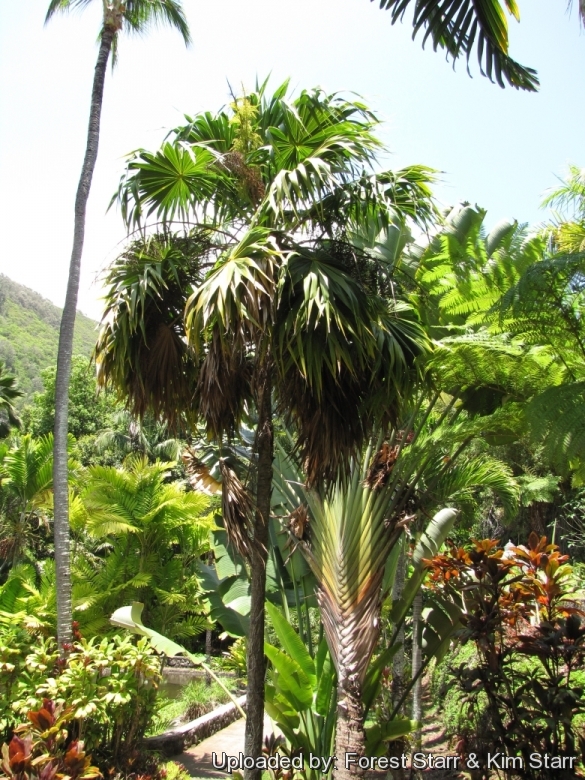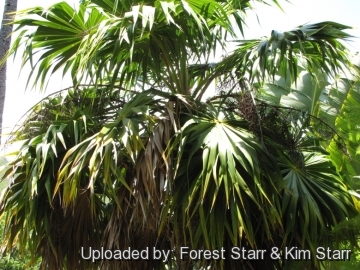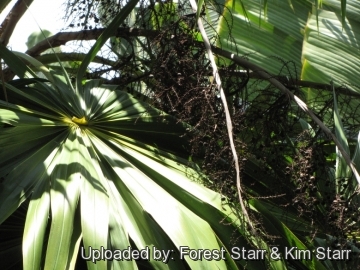
Thrinax parviflora Photo by: Forest Starr & Kim Starr
Habit at Iao Tropical Gardens of Maui, Maui, Hawaii (USA). May 22, 2012.
Origin and Habitat: Jamaica
Altitude range: Usually below 900 m elevation.
Habitat and ecology: Thrinax parviflora grows from neat the coast and on exposed and eroded limestone hills and mountains in dry places with deciduous, open woodland.
Synonyms:
See all synonyms of Thrinax parviflora
Common Names include:
ENGLISH: Broom palm, Thatch palm, Mountain thatch palm, Thatch pole (Jamaica), Broom thatch (Jamaica), Palmeto royal, Palmeto thatch, Jamaican Thatch Palm
Description: Thrinax radiataSN|24720]] is a fine small to medium palm topped by an open crown of large palmated fronds, plaited with stiff, lanceolate drooping segments, only moderately split and a thin trunk. Among the many Thrinax, this species from the mountains of Jamaica is one of the prettiest.
Stems: Slender, smooth, (1-)3-13(-15) m tall and 5-15 cm diameter swelling at the base unarmed.
Leaves: Palmate plaited, almost round and fan shaped. Petiole elongate, 0.3-1.6 m long, leaf sheaths with fine fibres. Blade with 35-60 thick and leathery leaflets, almost equal, lanceolate, nerved and with lines the middle ones 38-96 cm long, curiously twisted and curled, grass green and devoid of visible scales on their undersides.
Inflorescences: Arching, up to 1.5 m long and not greatly exceeding the leaves, with 7-22 primary branches, these granular-hairy at flowering time.
Flowers:Small, ivory-white to yellowish, moderately fragrant, opposite or in threes, hermaphrodite with five to fifteen stamen, borne on stalks more than 1 mm long.
Fruits: Globose, 6.5-7.5 mm diameter, shorter-stalked than those of Thrinax radiataSN|24720]] almost juiceless, kernel white within red in the middle
Subspecies, varieties, forms and cultivars of plants belonging to the Thrinax parviflora group
 Thrinax parviflora Sw.: (subsp. parviflora) has leaf segment tips conspicuously twisted and inflorescences shorter than the petioles.
Thrinax parviflora Sw.: (subsp. parviflora) has leaf segment tips conspicuously twisted and inflorescences shorter than the petioles.- Thrinax parviflora subs. puberula Read: has leaf segment tips not twisted and inflorescences equal to or longer than the petioles.
Bibliography: Major references and further lectures
1) Forest & Kim Starr Thrinax parviflora (Broom palm, thatch palm, mountain thatch palm). Plants of Hawaii. <http://www.starrenvironmental.com>. Downloaded on 21 August 2014.
2) Michael J. Balick, Hans T. Beck “Useful Palms of the World” Columbia University Press 1990
3) Thomas H. Everett “The New York Botanical Garden Illustrated Encyclopedia of Horticulture” Volume 10 Taylor & Francis, 1982
4) Andrew Henderson “Field Guide to the Palms of the Americas” Princeton University Press, 1997
5) “Encyclopaedia Londinensis, or, Universal dictionary of arts, sciences, and literature” Volume 23 1828
6) "Thrinax parviflora." rarepalmseeds.com , <http://www.rarepalmseeds.com> Web. 12 Sep. 2014.
7) Wikipedia contributors. "Thrinax." Wikipedia, The Free Encyclopedia. Wikipedia, The Free Encyclopedia, 8 Sep. 2014. Web. 11 Sep. 2014.
8) John Dransfield, Natalie W. Uhl “Genera Palmarum: the evolution and classification of palms” Kew Pub., 2008
9) Don Ellison, Anthony Ellison “Cultivated Palms Of The World” UNSW Press, 01/May/2001
10) Govaerts, R. & Dransfield, J. “World Checklist of Palms”. The Board of Trustees of the Royal Botanic Gardens, Kew. 2005.
11) Palmpedia contributors. "Thrinax parviflora" Palmpedia, PALM ENCYCLOPEDIA, <http://www.palmpedia.net> Downloaded on 26 Aug. 2014
12) Robert Lee Riffle, Paul Craft “An Encyclopedia of Cultivated Palms” Timber Press, Portland 2007
13) "Thrinax parviflora ." PACSOA Palms and Cycads wiki , <http://www.pacsoa.org.au> Accessed on 28 Aug. 2014
14) Robert Buist “The American Flower Garden Directory” E.L. Carey & A. Hart, 1839
15) Charles McIntosh “The greenhouse, hot house, and stove” 1838
 Crown at Iao Tropical Gardens of Maui, Maui, Hawaii (USA). May 22, 2012. Photo by: Forest Starr & Kim Starr
Crown at Iao Tropical Gardens of Maui, Maui, Hawaii (USA). May 22, 2012. Photo by: Forest Starr & Kim Starr Fruit at Iao Tropical Gardens of Maui, Maui, Hawaii (USA). May 22, 2012. Photo by: Forest Starr & Kim Starr
Fruit at Iao Tropical Gardens of Maui, Maui, Hawaii (USA). May 22, 2012. Photo by: Forest Starr & Kim StarrCultivation and Propagation: Thrinax parviflora is a robust palm of easy cultivation, that will thrive in tropical as well as subtropical climates, will grow in any soil and tolerates an occasional light frost. If you needs a small low maintenance, but graceful looking palm, it doesn't get any better than it.
Growth Rate: It is a slow growing palm, even in tropics, where it does the best. .
Soil: It does well even on poor, rocky, or sandy soils, as long as it is well drained.
Fertilization: It requires little of fertilizer. Use a perfect fertilizer diet including all micro nutrients and trace elements or slow release fertilizer applied during the growin season, or according to package directions, using a fertilizer specifically formulated for palms.
Water Requirements: It is tolerant of short periods of drought once established, though it prefers evenly moist but not consistently wet medium. When supplied with adequate moisture and fertilizer it is also fairly fast growing. It dislikes soggy soils.
Light: It prefers bright sunny locations, but it also does well in part shade with some direct sunlight. It will survive in rather heavy shade but "stretches" to lose its compact shape.
Salt tolerance: Like most Thrinax, it adapts well to coastal exposure and may be grown near the sea, best if given some protection (behind a dune, building, etc.). It does not take well to being inundated by salt or brackish water.
Wind resistance: High.
Hardiness: It is a relatively cold tolerant species and is able to survive temperatures as low as -4° C ( U.S.D.A. Zone: 10A-12B)
Roots: Usually not a problem
Maintenance: The fronds are persistent. For the healthiest and most attractive plant, keep the palm pruned. As the old fronds die, these should be trimmed off and the leaf bases allowed to dry out, but do not prune if the frond still has some green colour and avoid removing fronds above an imaginary 180 degree horizon. Palms recycle nutrients from dead or dying fronds and use them for healthier fronds.
Pest and diseases: Aphids; scales.
Human hazards: None
Uses: It is used massively in gardening and landscaping in many tropical and subtropical part of the world though in sheltered areas it will survive short periods below freezing point. It is frequently used along roadways, in parking lots, yards, patios, seaside and wherever there is limited space. It is also excellent in containers and urns. And thanks to its drought resistance and durability to heat it can thrive in harsh urban conditions.
Traditional uses: The leaves when dried are used for thatch in the manufacture of hats and roofing. The wood in Jamaica was used for piles in wharfs and buildings made in the sea, as they are durable, and the worms do not attack them.
Propagation: By seed. Can be grown from de-pulped seed. Place container in light shade or full sun.











